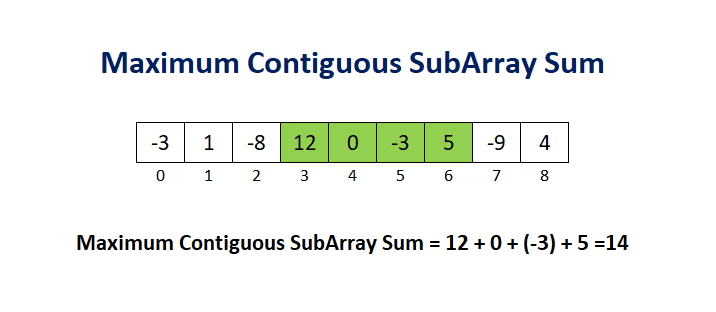Java Program - Maximum Subarray Problem
Kadane's algorithm is used to find the maximum sum of a contiguous subarray. Kadane's algorithm is based on the idea of looking for all positive contiguous subarray and find the maximum sum of a contiguous subarray.
In this algorithm, a variable called max_sum is created to store maximum sum of the positive contiguous subarray till current iterated element and a variable called current_sum is created to store sum of the positive subarray which ends at current iterated element. In each iteration, current_sum is compared with max_sum, to update max_sum if it is greater than max_sum.
Example:
To understand the kadane's algorithm, lets consider an array Array = [-3, 1, -8, 12, 0, -3, 5, -9, 4] and discuss each step taken to find the maximum sum of all positive contiguous subarray.

max_sum = current_sum = 0 Step 1: i = 0, Array[0] = -3 current_sum = current_sum + (-3) = -3 Set current_sum = 0 because current_sum < 0 Step 2: i = 1, Array[0] = 1 current_sum = current_sum + 1 = 1 update max_sum = 1 because current_sum > max_sum Step 3: i = 2, Array[0] = -8 current_sum = current_sum + (-8) = -7 Set current_sum = 0 because current_sum < 0 Step 4: i = 3, Array[0] = 12 current_sum = current_sum + 12 = 12 update max_sum = 12 because current_sum > max_sum Step 5: i = 4, Array[0] = 0 current_sum = current_sum + 0 = 12 Step 6: i = 5, Array[0] = -3 current_sum = current_sum + (-3) = 9 Step 7: i = 6, Array[0] = 5 current_sum = current_sum + 5 = 14 update max_sum = 14 because current_sum > max_sum Step 8: i = 7, Array[0] = -9 current_sum = current_sum + (-9) = 5 Step 9: i = 8, Array[0] = 4 current_sum = current_sum + 4 = 9
Hence, after all iterations, the value of max_sum is 14. The stating index point and end index point of this subarray are 3 and 6 respectively.
public class MyClass {
// function for kadane's algorithm
static int kadane(int Array[]) {
int max_sum = 0;
int current_sum = 0;
int n = Array.length;
for(int i=0; i<n; i++) {
current_sum = current_sum + Array[i];
if (current_sum < 0)
current_sum = 0;
if(max_sum < current_sum)
max_sum = current_sum;
}
return max_sum;
}
// test the code
public static void main(String[] args) {
int[] MyArray = {-3, 1, -8, 12, 0, -3, 5, -9, 4};
System.out.println("Maximum SubArray is: " + kadane(MyArray));
}
}
The above code will give the following output:
Maximum SubArray is: 14
To get the location of maximum subarray, variables max_start and max_end are maintained with the help of variables current_start and current_end.
public class MyClass {
// function for kadane's algorithm
static void kadane(int Array[]) {
int max_sum = 0;
int current_sum = 0;
int n = Array.length;
int max_start = 0;
int max_end = 0;
int current_start = 0;
int current_end = 0;
for(int i=0; i<n; i++) {
current_sum = current_sum + Array[i];
current_end = i;
if (current_sum < 0) {
current_sum = 0;
//Start a new sequence from next element
current_start = current_end + 1;
}
if(max_sum < current_sum) {
max_sum = current_sum;
max_start = current_start;
max_end = current_end;
}
}
System.out.println("Maximum SubArray is: " + max_sum);
System.out.println("Start index of max_Sum: " + max_start);
System.out.println("End index of max_Sum: " + max_end);
}
// test the code
public static void main(String[] args) {
int[] MyArray = {-3, 1, -8, 12, 0, -3, 5, -9, 4};
kadane(MyArray);
}
}
The above code will give the following output:
Maximum SubArray is: 14 Start index of max_Sum: 3 End index of max_Sum: 6
Time Complexity:
The time complexity of Kadane's algorithm is Θ(N).
Recommended Pages
- Java - Swap two numbers
- Java Program - Fibonacci Sequence
- Java Program - Insertion Sort
- Java Program - Find Factorial of a Number
- Java Program - Find HCF of Two Numbers
- Java Program - Merge Sort
- Java Program - Shell Sort
- Stack in Java
- Queue in Java
- Java Program - Find LCM of Two Numbers
- Java Program - To Check Whether a Number is Palindrome or Not
- Java Program - To Check Whether a String is Palindrome or Not
- Java Program - Heap Sort
- Java Program - Quick Sort
- Java - Swap Two Numbers without using Temporary Variable
- Java Program - To Check Armstrong Number
- Java Program - Counting Sort
- Java Program - Radix Sort
- Java Program - Find Largest Number among Three Numbers
- Java Program - Print Floyd's Triangle


